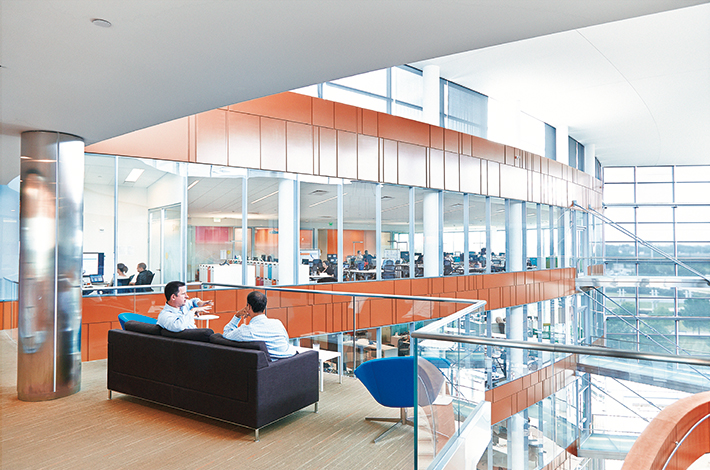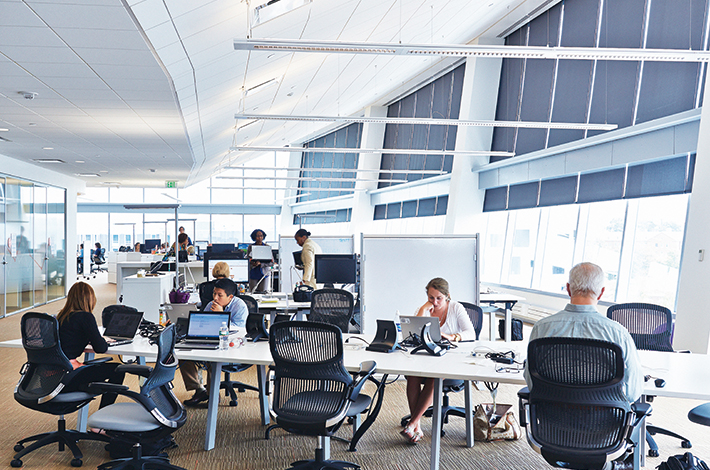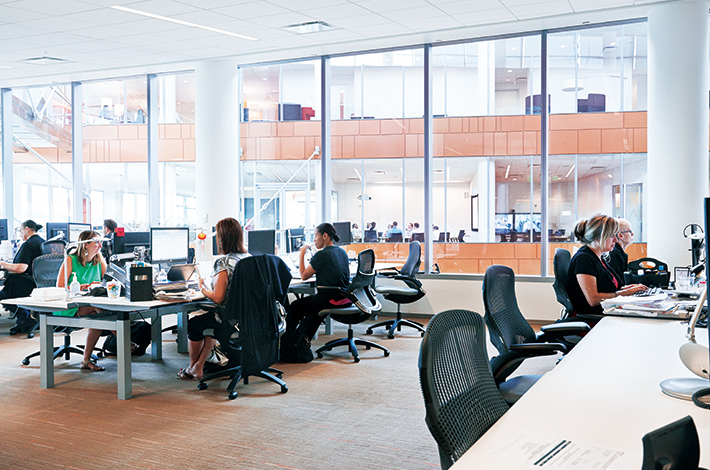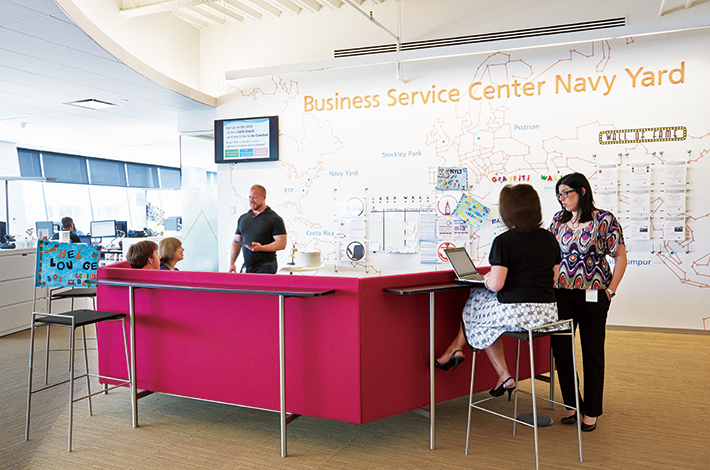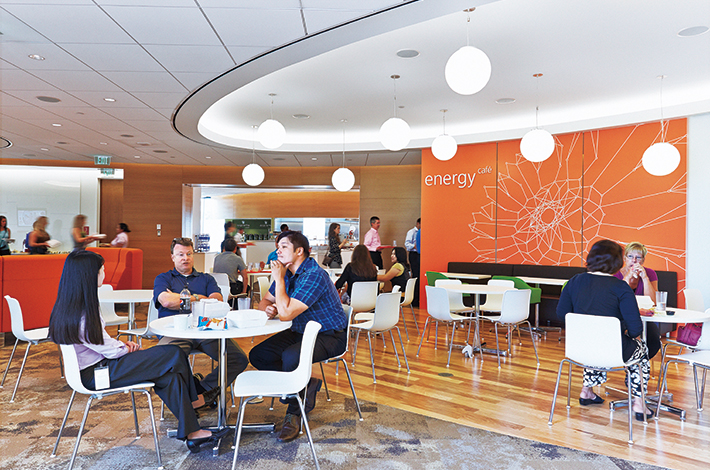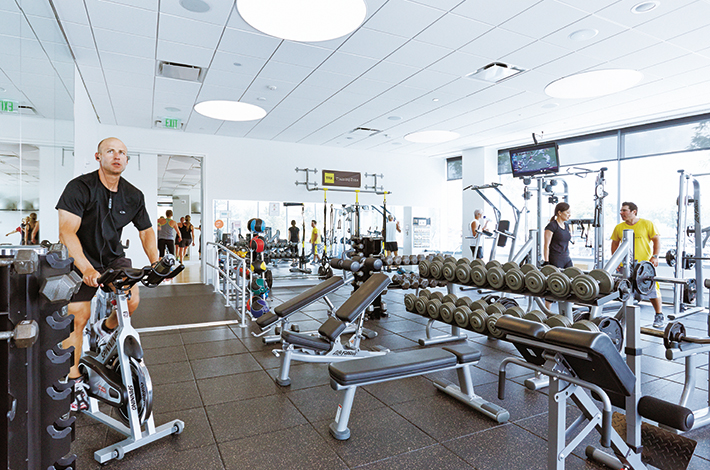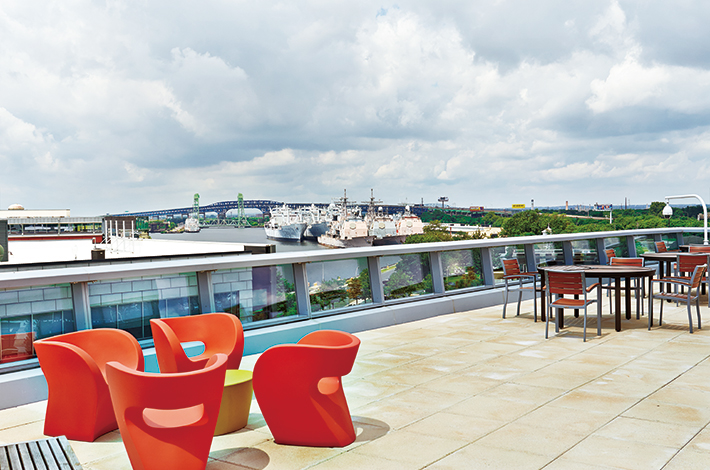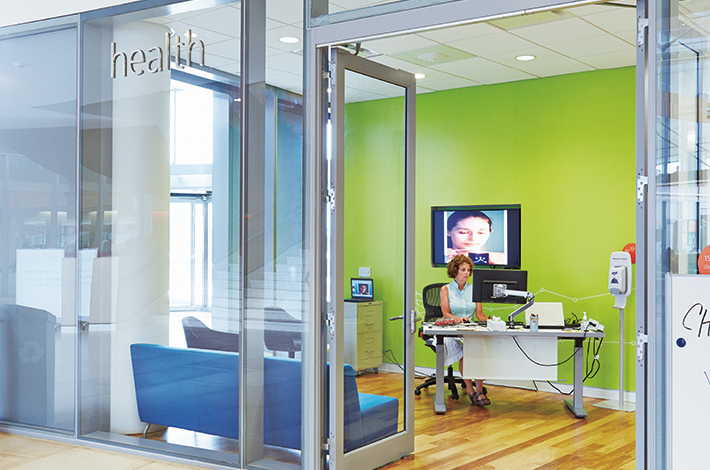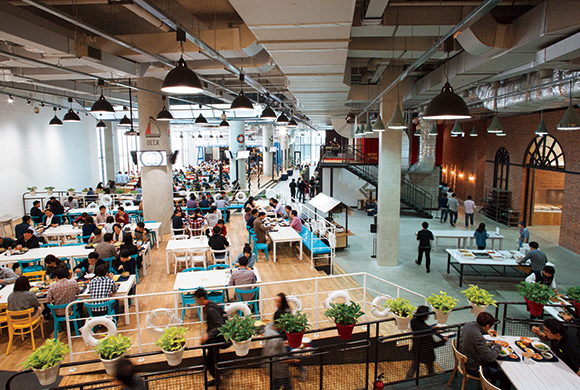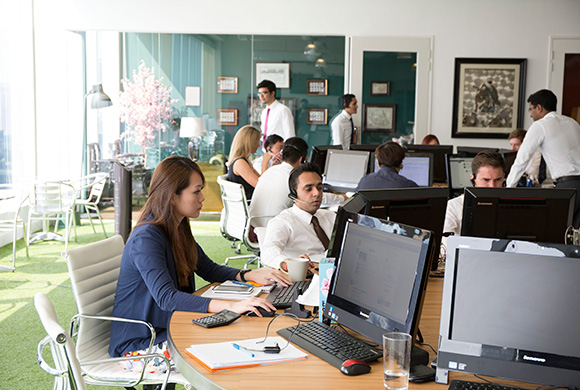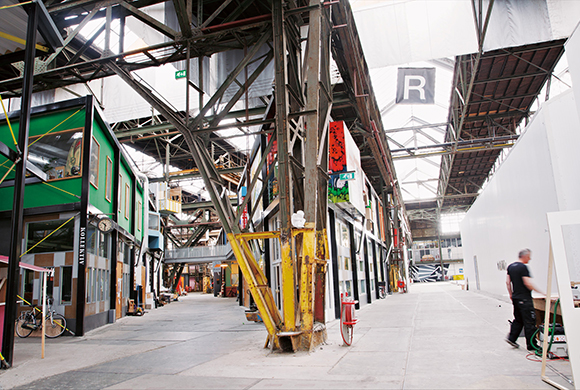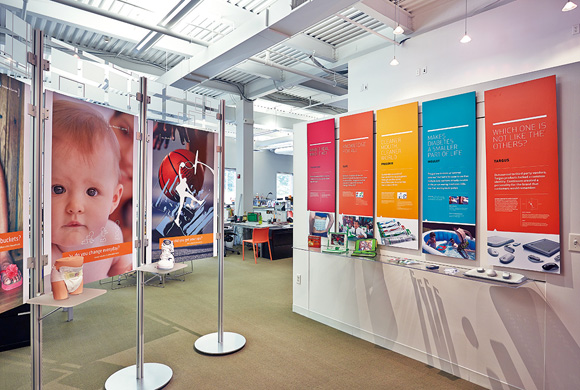Workplace
Sep. 3, 2018
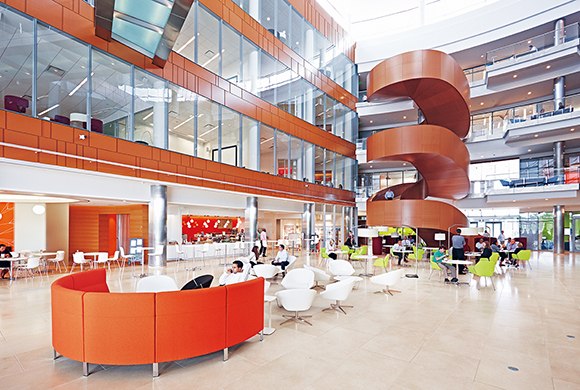
Transparency beyond industry standards
The North America office of a UK-based pharmaceuticals firm
[GSK] Philadelphia, USA
The concept of “Neighborhood” has changed peoples’ way of working
Employees sitting in a fixed location: this common practice was abandoned as people sit near those with whom they are doing work. We discover a clever scheme that allows for rapid development of exchange inside and outside the company.
UK-based pharmaceuticals firm GSK was looking for a workplace that fits the times, and continued to actively invest in this goal. We visited the company’s North America headquarters in Philadelphia, completed in 2013. The company’s administration and marketing departments are located here.
The company had been in its previous office, an old building located in the downtown area, for 30 years. The new office is in an area of redevelopment known as The Navy Yard, as it is located in the port area. GSK’s goal is to have a high degree of transparency both in the company and outside, to visualize information and realize an environment in which a highly flexible working style is possible. This would also be an environment where employees can better focus on their work and be more productive. John B. Campbell, Principal at Francis Cauffman in charge of the interior design, compares the ways of working in the old and new offices.
“Technology as a tool has transformed the way we work, and the traditional office is no longer an efficient or effective work environment,” he says. “In the new office, the focus is to create a work environment aligning the business culture and work processes to drive results. This means we don’t mind where the employee is doing their job—we’re focused on their results.”
They call this new style of work Smart Working. People are based in neighborhoods with their colleagues, but can move seamlessly to different work settings throughout the building during the day. This has resulted in smooth exchanges both within and outside departments.
While reducing the number of seats in the work areas, sofas were placed in the area around the landing of the stairs for meeting, while a large number of chairs were also set in the cafeteria and on the roof. “Even if all the employees assigned to the building turned up, there are plenty of spaces available for them. Mr. Campbell says. “It’s even OK to hold meetings outside on the roofdeck when the weather is nice.
The goal for each person is to choose the most convenient and useful place to work each day. This system is what separates Smart Working from more generic “open plan” working, explains GSK’s Project Executive for The Navy Yard, Ray Milora. “All of the desks and chairs at Navy Yard are designed for ergonomics, and in many cases were chosen by employees,” he says. “The height of both chairs and desks can be adjusted, and people can use monitors if needed. Specially-shaped chairs have been placed in the spaces designed for team use and throughout the building to ensure a variety of working environments.”
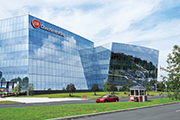 The building has a unique shape designed for the efficient use of lighting. The space known as the Hub in the center of each floor next to the central stairs was designed for informal communications between employees.
The building has a unique shape designed for the efficient use of lighting. The space known as the Hub in the center of each floor next to the central stairs was designed for informal communications between employees.
Established: 1999
Sales: £26.4 billion(in 2012)
Profit: £7.4 billion(in 2012)
Employees: 99,488(2012)
(all figures global totals)
https://www.gsk.com
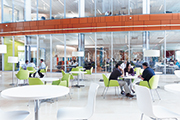
Tables in the atrium area are often used for meetings.
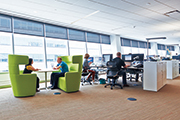
In the work areas, White Noise—sound intended to extinguish other noises and allow people to concentrate—is played. The building walls are slanted so that sunlight does not directly enter.
One consistent word in the creation of the spaces was “connectedness.” The 36 floors of the previous office were compressed down into four, and all employees can now look out and see what other people are doing. A symbol of this is the atrium at the center of the building. It really is the heart of the building, and can be seen from anywhere within the offices. The president of GSK North America, Deirdre Connelly, looks out at the atrium from her neighborhood on the first floor. Employees have access to her throughout the day. Because of this, the volume of email she sends has been cut by 35 percent. The atrium is also the place where many different kinds of events are held.
In the center of each floor is a unique space known as the Hub. This is an informal space for employees to gather. Refrigerators, recycling bins, vending machines, microwave ovens and other equipment are provided here, allowing for a variety of uses. The space can be used for work, for having lunch—employee birthdays are even celebrated here. As the Hub name implies, this is a place where people can connect, and it was designed to encourage communications.
Looking around the office, the eyes are drawn to the different branding posted on the walls. For example, on the emergency stairs is a sign reading, “The average person gains two pounds per year. Don’t be average; take the stairs.” The goal is to have an effective way for GSK to transmit messages to its employees. Well-being is one of these. Health is indispensable for doing good work. Employees using the stairs are one part of well-being. But things would end if there were only verbal encouragement, so a gym has also been set up on the first floor of the building. There is a bicycling sharing program so people can use bikes to move around The Navy Yard. A healthy menu has been established in the cafeteria
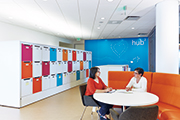 The space known as the Hub is intended to encourage informal communications.
The space known as the Hub is intended to encourage informal communications.
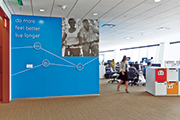 Branding is posted throughout the building, on every floor, raising the esprit de corps of the employees working there.
Branding is posted throughout the building, on every floor, raising the esprit de corps of the employees working there.
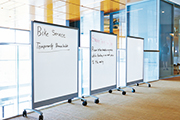 Whiteboards are set in the center of the floors, where employees, or the concierges stationed on the floor, can write areas announcements/news.
Whiteboards are set in the center of the floors, where employees, or the concierges stationed on the floor, can write areas announcements/news.
A staff member known as the concierge has also been permanently assigned to each floor. Their job is to monitor and resolve any issues on the floor, and write these down on a whiteboard so that everyone takes ownership. In actuality, they have played an important role in problem solving. 。
“Having the concierge who will help employees on a face-to-face basis has very large benefits,” Mr. Campbell says. “Rather than trying to connect to a remote help desk, this is a much more hands-on, flexible and rapid response approach to problem solving. The concierges also suggest ways in which to more effective utilize the office. If there’s an open space, they might say to management, ‘That area is only occupied about 50 percent of the time. Why not bring in some people from elsewhere.’ There are three or four concierges for 1,300 employees, so it’s quite cost effective.”
The company is also conscious about environmental conservation. This is shown by the two platinum LEED (environmental evaluation system) awards it has won. One goal is to keep energy and water usage to the absolute minimum. For example, lighting is automatically switched on only when someone is using a space. The amount of illumination is also varied in accordance with the amount of sunlight available though the day. “By converting to digital, we’ve significantly reduced the amount of documents distributed on paper,” Mr. Milora says. One background to this is that in general illumination has been reduced. Also, the wall on the south side of the building is on the inside of the building, what that on the north side is outside. This helps to protect against the direct rays of the sun entering and warming the building. Sixty percent of the rooftop is covered in vegetation, which helps to keep the entire building cooler.
An environmentally-friendly building is also people-friendly. If you listen very carefully, you will just be aware that quiet White Noise is played throughout the building. It’s not a blaring noise. Rather, it helps to eliminate the noise from the surrounding area, so people can better concentrate on their work. Low VOC paint has been used, which also reduces paint odors—all signs of the concern for employee health.
“Direct sunlight is controlled to avoid glare, but it’s important that people can look out at the scenery through the large windows, which also allow natural lighting of all the desks,” Mr. Campbell says. “Only the restrooms don’t have natural lighting. This is because well-being really is so important for us.”
GSK is a company with a long history, but the new office sends several messages. One is that employees have a more flexible, more independent working culture. Communication between employees has increased, as have the points of contact with those outside the company. The speed of collaboration inside and outside the company will probably increase. The environment of Smart Working, and its focus on results, has been created. And, finally, loyalty: that is, that the employees become people who are proud of working at this place.
“‘This is like a home,’ is the way I put it,” Mr. Campbell says. “This is a new office that brings in the thinking of a home-like, private space. That is why we have Connectedness and communication. It used to be that only the area around the desk was one’s home. I think that now there is the feeling the entire building is like home. I think there is also meaning in the fact that home is in the values system that is very important to GSK.”
“Employees now bring their families here,” Mr. Milora says. “They invite their spouses, kids and families to lunch. That’s great!”
WORKSIGHT 05(2013.12)
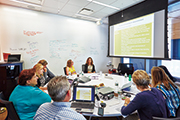
Meeting tables are round, to discourage hierarchy.
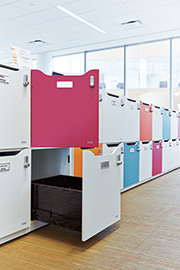
The lockers are also the result of employee ideas. In the end, the decision was for doors on the upper row, drawers below.
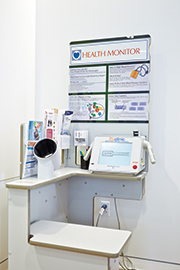
Equipment for measuring blood pressure. Another sign of the forethought regarding employee health.


